

Halifax is by far the largest city in Maritime Canada as well as the capital of Nova Scotia, and it was the location where I was heading next on my trip. Halifax has a population of just over 400,000 people, although this is a somewhat exaggerated number because the "city" also includes a lengthy regional municipality that stretches far out into the surrounding countryside. Regardless, Halifax is a genuine city and it represented a major departure from the overgrown towns like Portland and Saint John that I had been visiting to date. Halifax shares the same historic association with fishing and shipbuilding common elsewhere along the Atlantic coast, but it's also known for its significant military presence. This is where the Canadian Atlantic fleet has been based historically, and Halifax was fortified against first the French and later the Americans in order to protect Britain's Canadian possessions. By sheer coincidence, I happened to be visiting Halifax on the same day as a major fleet review, and this would end up coloring my impressions of the city.

It took about three hours to reach Halifax from the Hopewell Rocks that I had visited along the Bay of Fundy. Most of the drive took place in a continued rain, although the precipitation finally stopped and began to clear up around the time that I reached the suburbs of Halifax. The trip was uneventful for the most part, conducted along nondescript highways that didn't serve up anything too interesting along the way. I will mention though that the town of Truro, a highway junction in the central part of Nova Scotia, had a fantastic selection of fast food options on display. It was a great place to stop and get a quick dinner before continuing on to the big city.

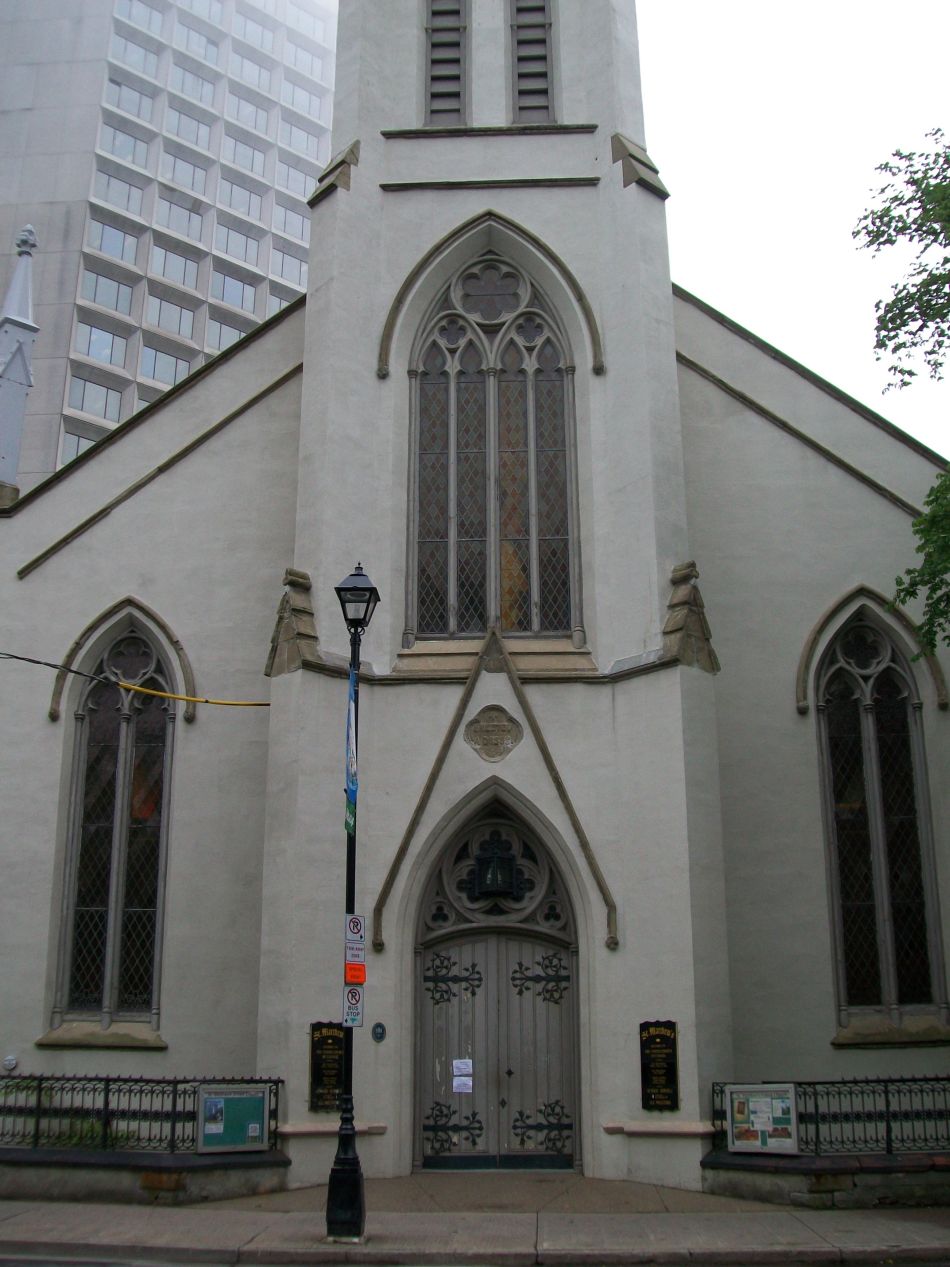


I spent the night in the Heritage House hostel located on the southern end of the downtown. This was one of the quieter parts of Halifax, while fortunately still being within walking distance of the main attractions about ten blocks to the north. I woke up early again as normal for me on these solo trips and set out to explore the immediate area. It turned out that I was near Edward Cornwallis Park, named after the founder of Halifax. This man was the father of the more famous Charles Cornwallis who surrendered to the American/French force at the Battle of Yorktown, and his reputation has taken a serious hit in recent decades due to increasing revelations about his terrible treatment of the local Mi’kmaq Native Americans. The statue of Edward Cornwallis that I spotted in a park on this visit has since been removed by the city. A couple blocks to the north was the Old Burial Ground, the city's oldest cemetery dating back to the colonial period, and St. Mary's Basilica. This church dating from 1820 was one of the first Catholic churches in Halifax, catering to the minority of French speakers in this otherwise overwhelmingly Anglo-centric city. There were some pretty stained glass windows here, and although the church was open and I was able to go inside, my pictures with this cheap camera were too dark to make out much in the way of details. I wish that I could send my current camera back in time for use on this trip.




Several blocks to the west of St. Mary's Basilica was the Halifax Public Gardens, a small park space of green grass and walking trails. These were Victorian era public gardens formally established in 1867, and they are apparently a popular local setting for wedding and prom photos. The landscapers seemed to like to write out messages in flowers, with one display commemorating the 2011 Canada Winter Games to be hosted in Halifax, and another one celebrating 100 years of Canada's navy and marines. This was the subject of the fleet review being held in Halifax, and I would see much more on this same theme later in the day. It was still early in the morning at this point and the gardens were both pretty and mostly empty when I visited.

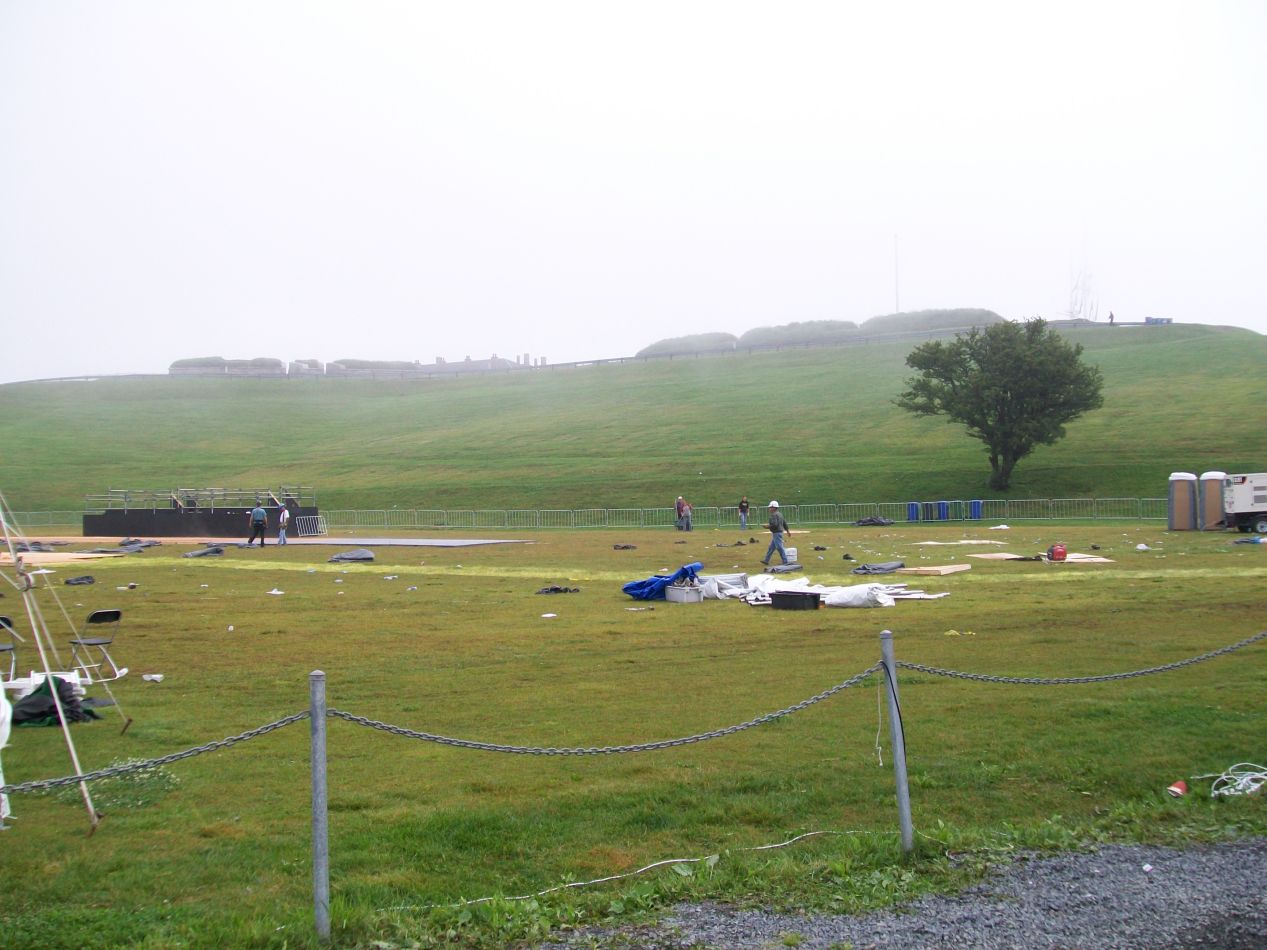


The first major attraction that I visited on the day was the Halifax Citadel. Situated on the heights of the tallest hill in the downtown, the Citadel was the fortified home of Halifax's military garrison from the early colonial period until well into the 20th century. It was first established as Fort George at the same time that Halifax was settled in 1749, intended for protection against both the French and their local Native American allies. The initial fortifications saw combat multiple times in this period as Halifax was raided by the Mi’kmaq and French Acadians. Later on, the Citadel was repeatedly strengthened due to British fears of an American attack that never ended up arriving. Per standard military doctrine the Citadel was placed up on top of the highest hill in Halifax, and I tried to capture in these pictures how it was a clear walk up a steep hill to reach the place. There were good views of the rest of the downtown from up there, or at least there would have been if it hadn't been such a foggy morning. A pair of ceremonial guards in period dress were nice enough to let me take a picture of them at the gates leading into the Citadel.

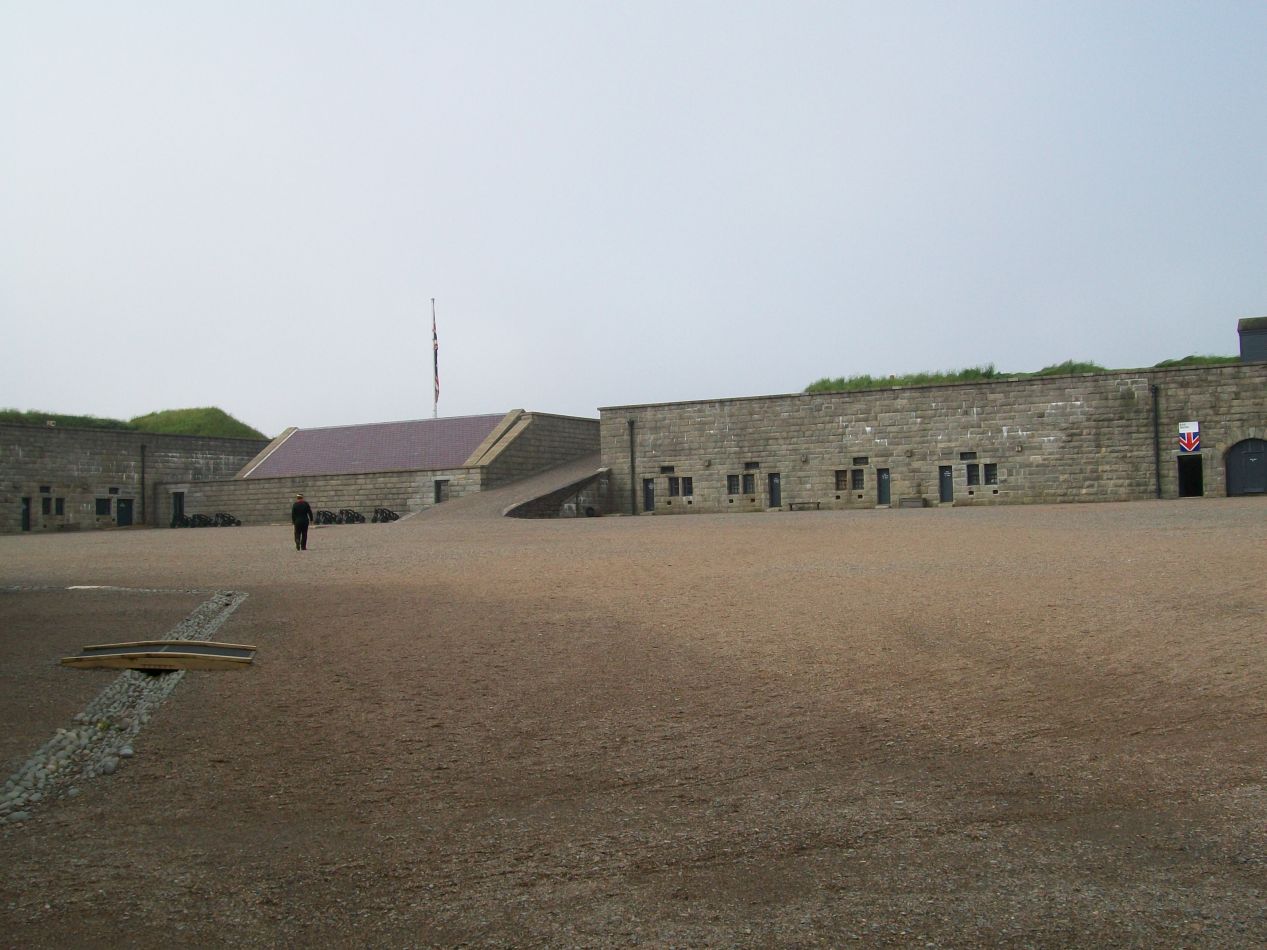


The current version of the Citadel is the fourth fortification to be constructed on this site, and took more than two decades to build between 1828 and 1856. The design of the fortress is a classic star-shaped model in the trace italienne style, with star-shaped protrusions on the corners to deflect incoming artillery shots while providing platforms for defensive cannons to return fire. The whole thing was sunk down into the earth to make it more difficult to attack with artillery pieces, again standard for this sort of fortification. Most of the interior of the Citadel was an empty space that could be used as a parade ground for the defending soldiers, with a single building that currently housed the Army Museum of the Halifax Citadel. The rest of the structures were built into the walls of the fortress itself, again to provide a place where supplies could be stored and soldiers quartered where they would be protected against incoming artillery. There was a squad of soldiers in period costume performing a morning drilling exercise right when the Citadel opened for the day, and I had the chance to watch them march back and forth along with the scattering of other tourists who had arrived.

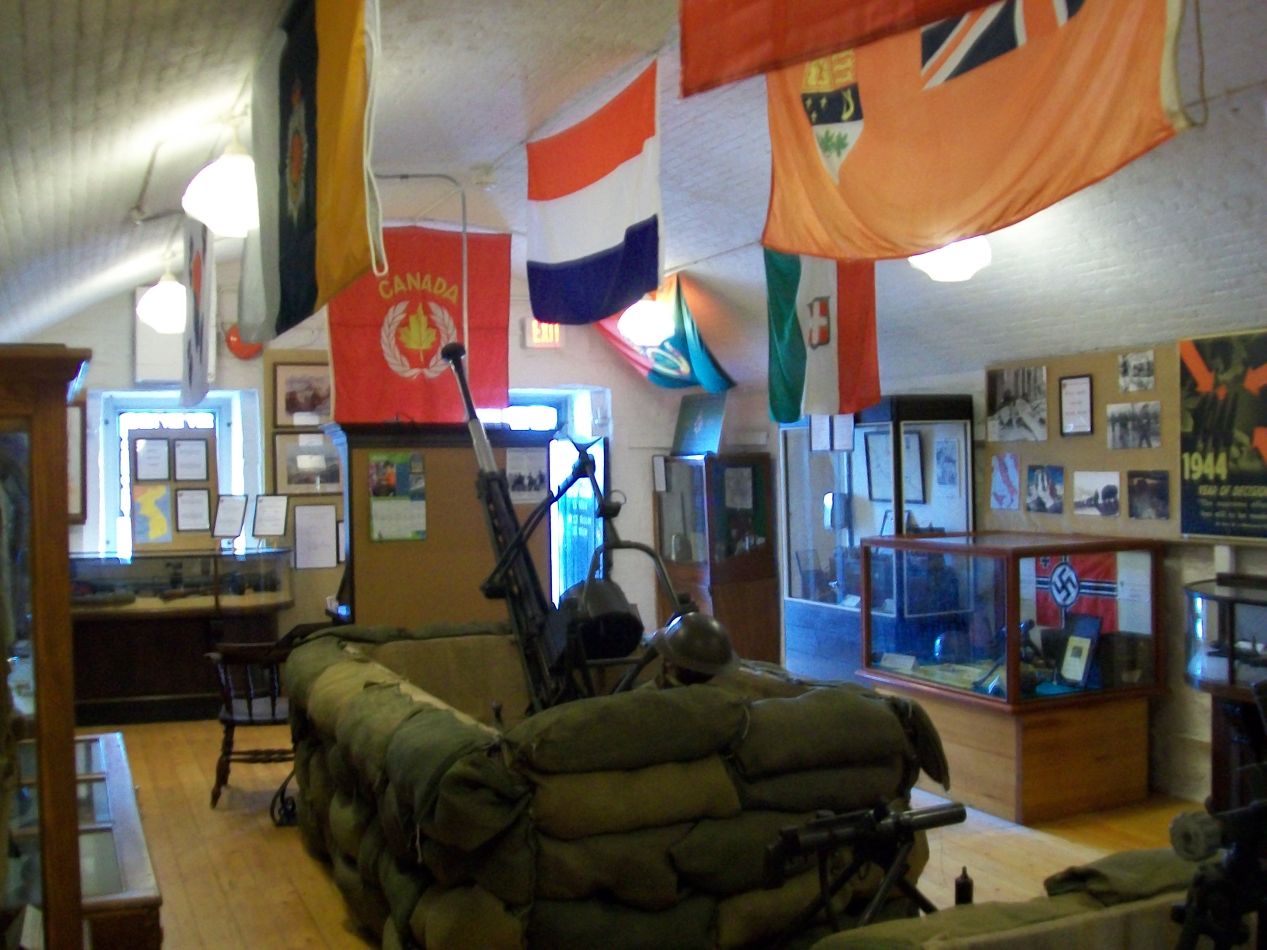


This next group of pictures was taken from the museum mentioned above, located in the one building standing in the interior of the Citadel. There was a lot of military history on display here, in particular several displays about the different types of artillery weapons used in the 19th century and the greater effectiveness of rifled as opposed to smooth-bored cannons. The wildest setup was the big display in the first picture above, which theorized what an imaginary attack against the Halifax Citadel by the United States would have looked like in the 1860s. This was a real oddity for an American like myself to be reading about. Other parts of the museum were recreations of what regimental quarters would have looked like for the soldiers stationed in the Citadel. I also appreciated the aerial photograph of the Citadel, which made the star-shaped configuration easy to recognize.

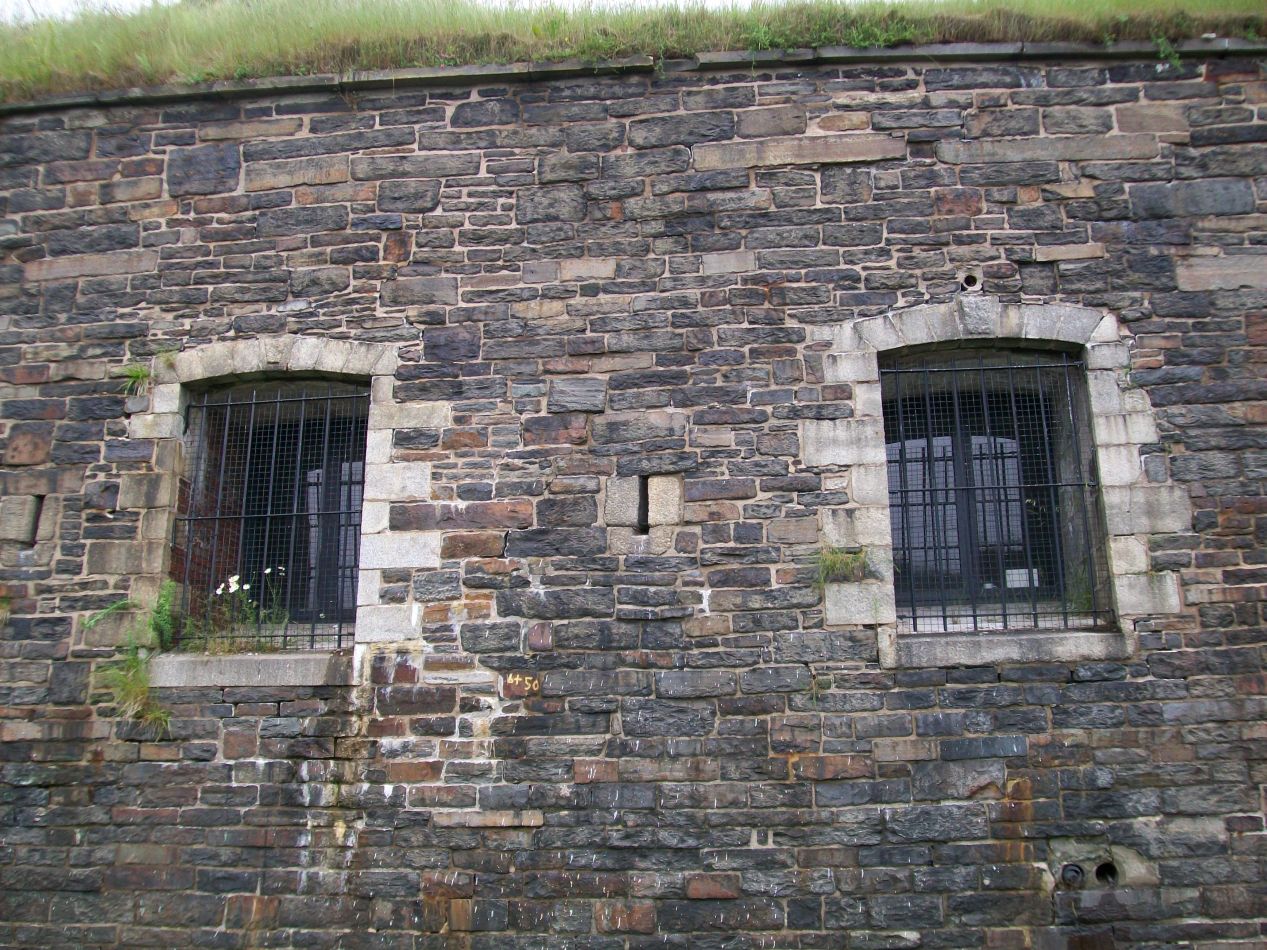


Finally, I snapped these pictures of the walls that made up the outer defenses of the Citadel and the dry moat located in between them. The structure was designed in this fashion both to repel human attackers trying to storm the gates as well as provide as much protection as possible from incoming shells launched from ships in the harbor. The current version of the Citadel never faced any combat and therefore we don't know how well it would have stood up to the stresses of battle. Aside from quartering the 78th (Highlanders) Regiment of Foot for a period of time, the modern Citadel most notably housed an internment camp of German immigrants during the First World War - not exactly the proudest moment for the city. I enjoyed my visit nonetheless, and would recommend the Citadel to anyone who enjoys military history.

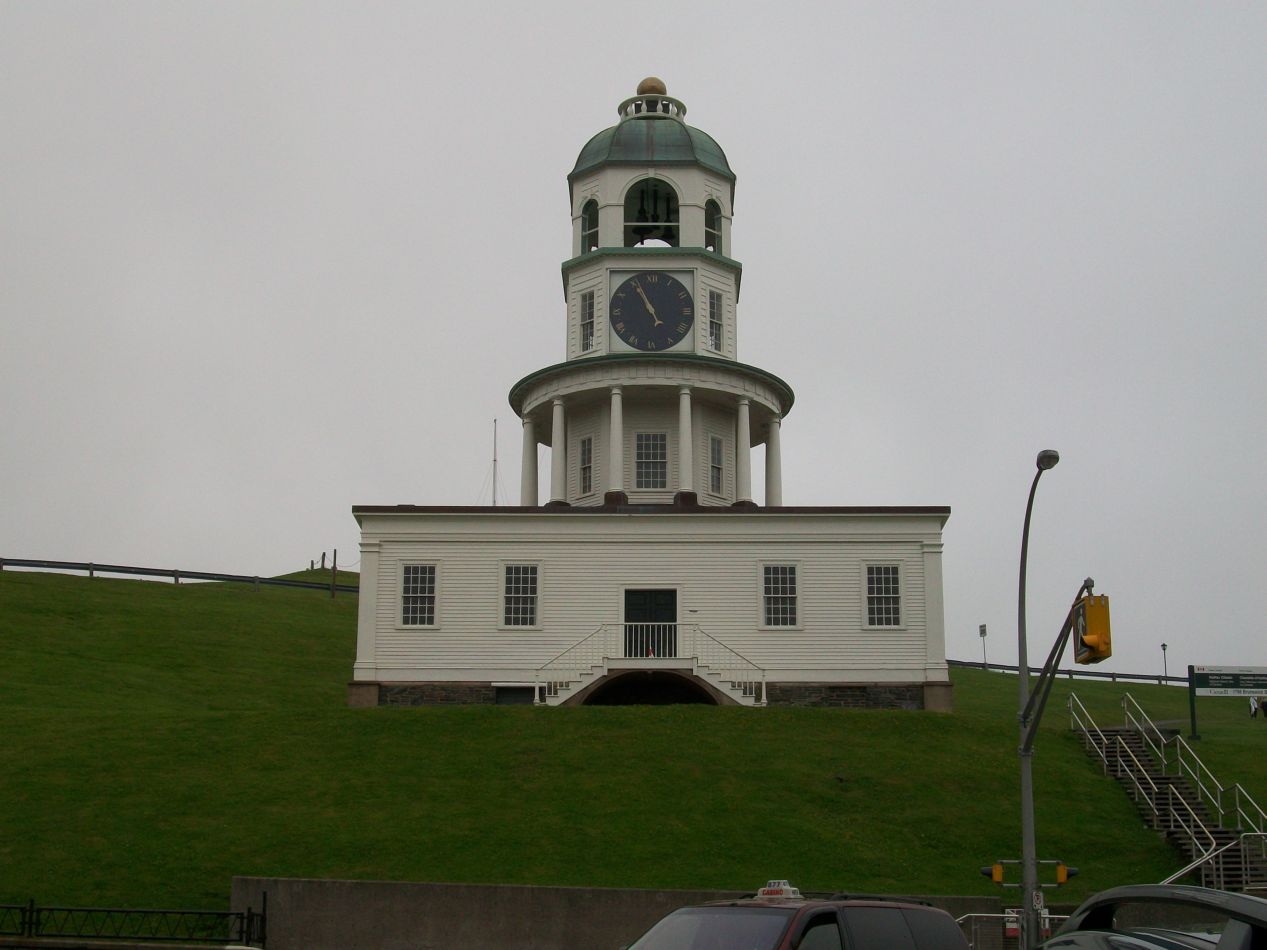


I left the Citadel and walked down the hill towards the center of downtown Halifax. I passed by the Old Town Clock first, which stood by itself on the hillside leading down from the Citadel's heights. A block away was the location of the oldest church in Halifax, St. Paul's Chuch. This structure was completed in 1750 and the original wooden structure still forms the core of the building today. St. Paul's was open to the public and looked to be a typical Anglican place of worship. There was a memorial inside to the locals who perished serving overseas in the Great War, and another larger memorial outside the church on the open space known as the Grand Parade. The dates of World War II and the Korean War had been squeezed onto the outdoor memorial at a later date as Canada's overseas wars continued to accumulate.

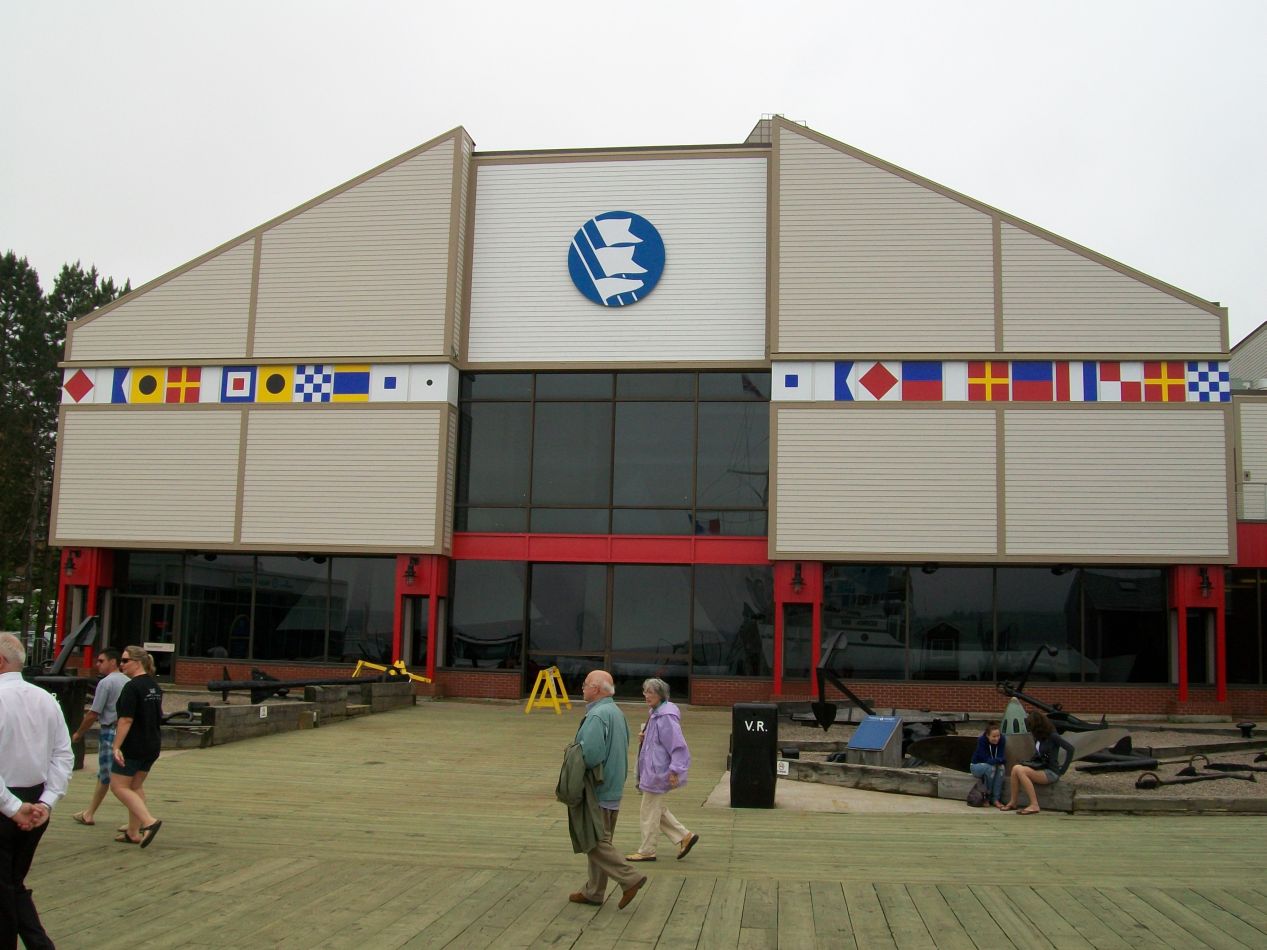


Halifax City Hall was also nearby, the home to the city's municipal government. This red sandstone building was designed in an eclectic style and completed in 1880; it is one of the largest buildings in the province of Nova Scotia. From the Grand Parade I walked down to the harborfront where the Maritime Museum of the Atlantic was located, the structure with the naval flags decorating the outside and one of the city's best museums. My plan had been to spend an hour or two exploring the museum, only for me to discover that it was closed on this day. That was due to the fleet review that was going to take place later on, which had the harbor full of ships and some tight security concerns. For the moment, the harbor was still covered in a layer of dense morning fog, with the clouds thick enough that I couldn't see the suburb of Dartmouth on the other side of the water. There was already a CBC television crew getting their equipment set up to broadcast the day's festivities, and some old fashioned ships festooned with naval flags sitting on the docks to provide a backdrop.


The specific occasion being commemorated was the 100th anniversary of the creation of Canada's navy, with the centennial dating from 1910 to 2010. This was a big enough deal that Queen Elizabeth II of the United Kingdom was on hand to take part in the naval review, her first visit to Halifax in decades. Sometimes I have really bad luck when it comes to travel, and sometimes I have really good luck - this was about as good as my luck had ever been. I was in Halifax for exactly one day and it coincided with a visit from the queen herself? That was dumb luck on an epic scale. This reviewing stand had been set up in front of the HMCS Sackville, a World War II era Canadian ship that normally serves as a naval museum. Dignitaries were already gathering for a short speech to be given by the queen at that podium a few hours later. While I was able to walk around and take some pictures at the moment, this was a private ceremony for invited guests and the media, not a place where I could hang out and see the queen. I was kindly told to move along by the security guards.

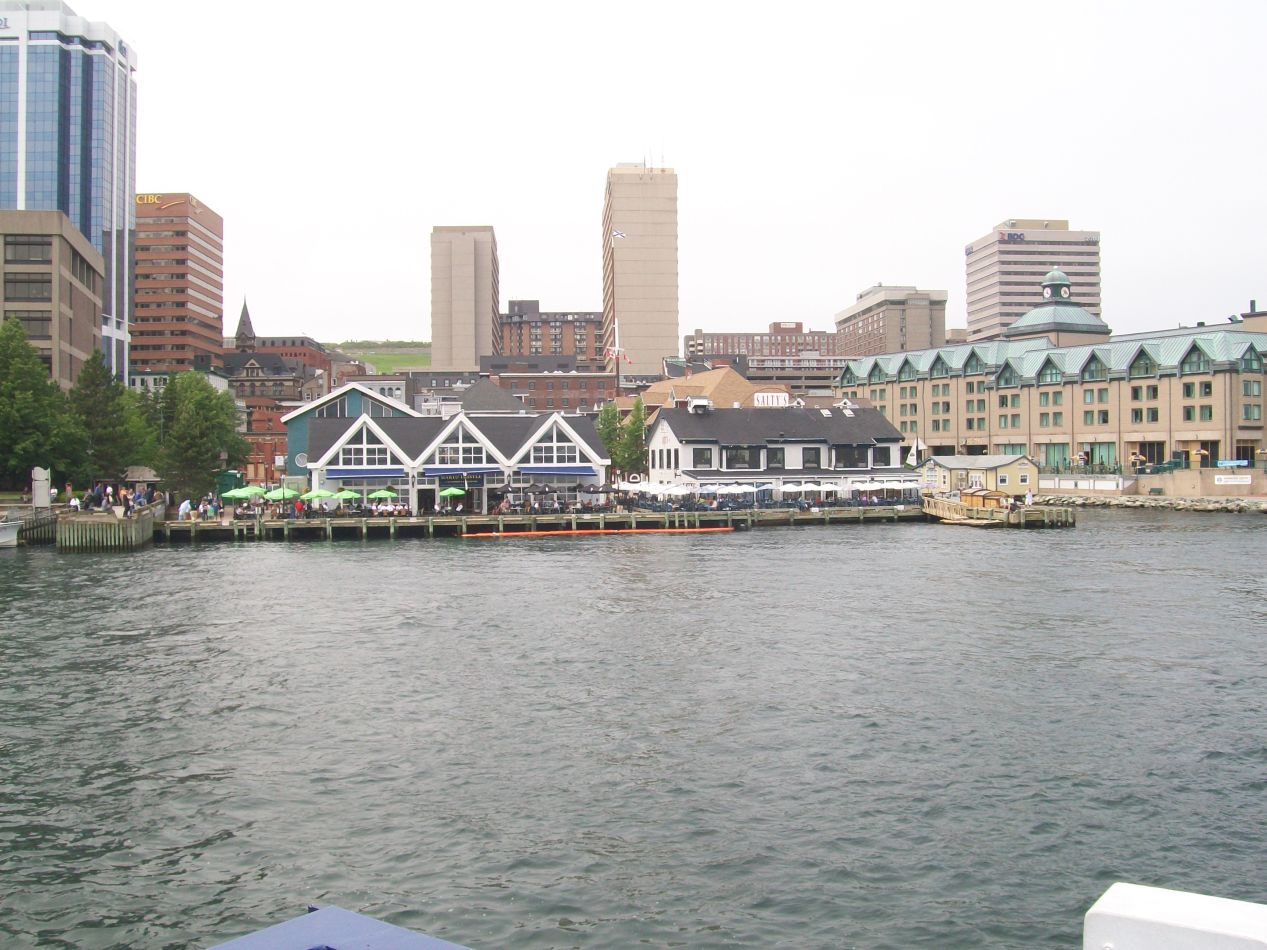


With no chance to see the Maritime Museum of the Atlantic, I skipped ahead to the next activity that I had planned on my itinerary: taking the ferry across the harbor to Dartmouth. This would give me a chance to see more of the city from the water, as well as get closer to some of the warships that were gathering in Halifax for the fleet review that afternoon. I included a picture of the ferry's route above, the yellow path on the left side of the drawing heading from downtown Halifax to Dartmouth. I had a view of some of the restaurants located along the waterfront as the ferry pulled away from the docks, along with a good view of the land rising quickly uphill towards the Citadel's heights. Out on the water I was treated to fantastic views of the military ships entering the harbor. In addition to a bunch of Canadian ships, I spotted several from the United States as well, flying both American and Canadian flags today in commemoration of the occasion. These weren't token little ships either; I spotted destroyers and multiple carriers making their way through the harbor. It was a good thing that Halifax has a natural deepwater harbor or else these massive warships would have had trouble staying afloat.

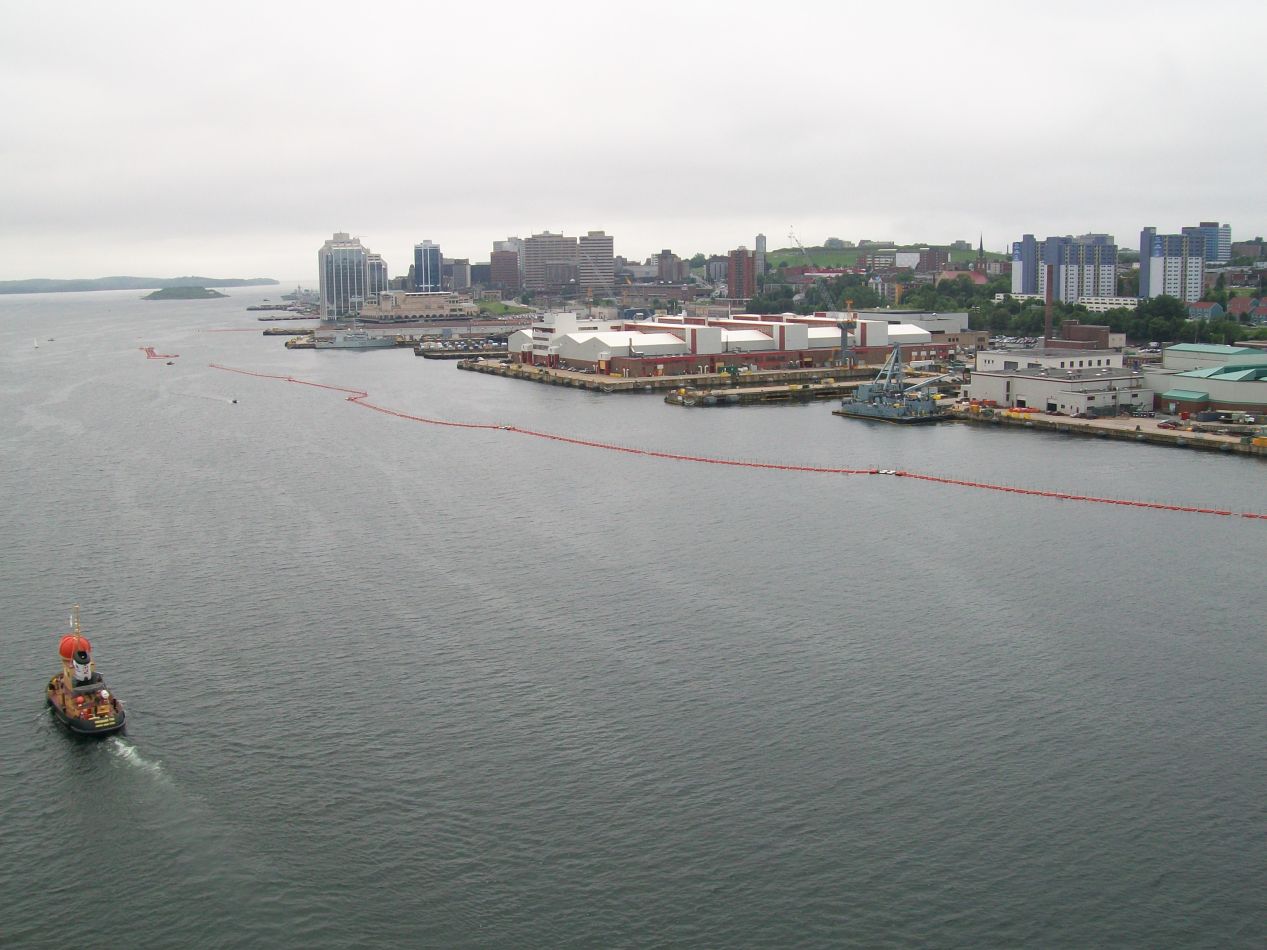


My plan had been to take the ferry across to Dartmouth and then return back across the harbor by walking on the Angus Macdonald Bridge. This was the main highway that I had used to enter the city the day before, and I figured that I would get some excellent bird's eye views of Halifax as I crossed it. This turned out to be true, and the tall height of the bridge (100 meters / 330 feet) allowed me to look out over the downtown and see the ships congregating in the harbor for the fleet review. The weather had been cloudy all day, but the fog was beginning to life and visibility was much better than before. The Macdonald Bridge was flying a pair of huge Canadian flags atop the central spans and they provided a festive look to its otherwise unrelieved green-painted steel. The one thing that I underestimated was the distance involved in this crossing: it took a long time to walk from the ferry landing to the bridge, and then more time to cover the 1.3 kilometers / 0.8 miles to the other side. While the pictures were pretty cool, this time might have been better spent sightseeing elsewhere.

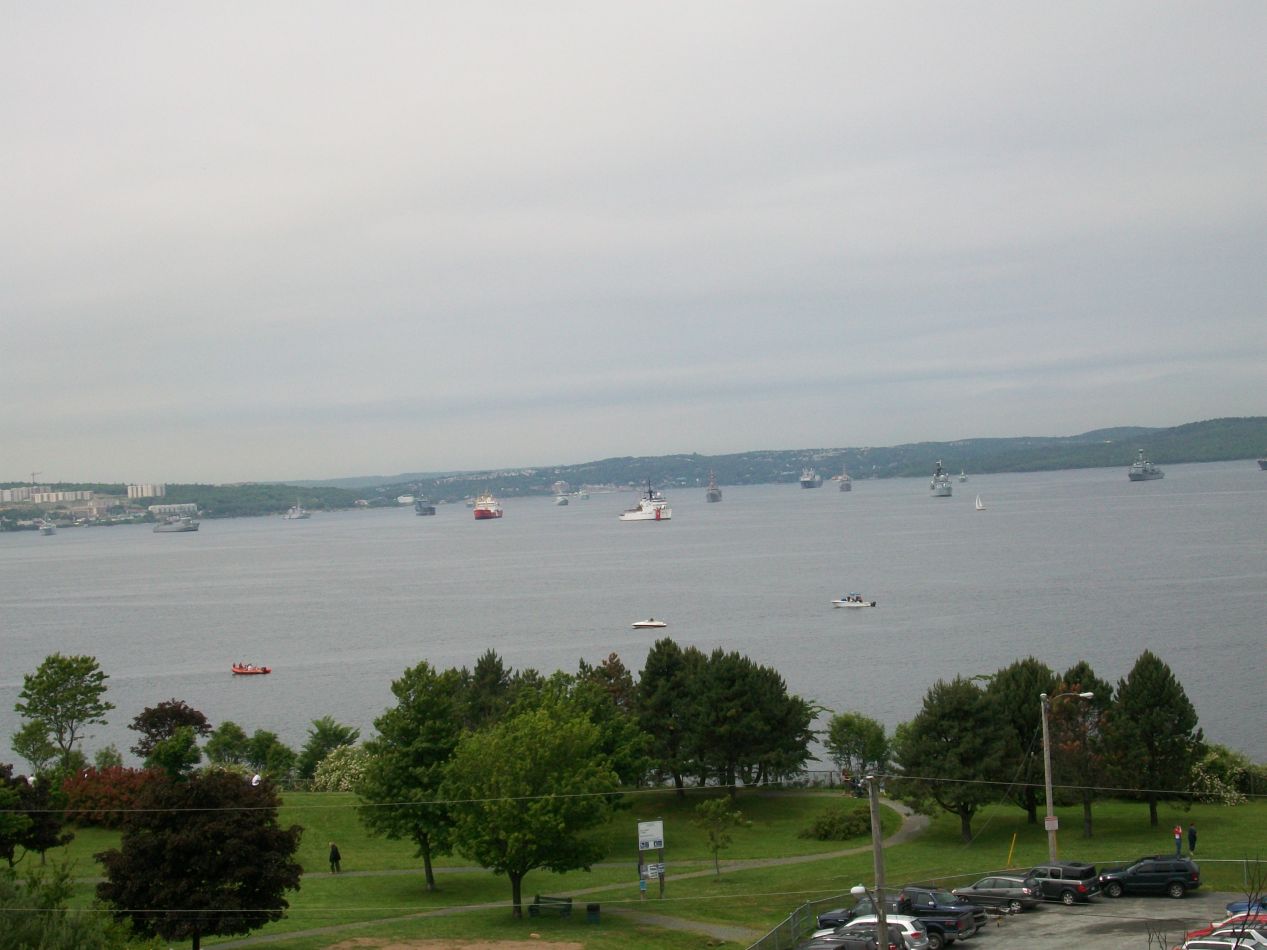


By now it was early afternoon and the fleet review would be getting underway soon. The main action was set to take place in Bedford Basin, an expanse of water located further up the harbor from the downtown in a sheltered area. I had scoped out a small public location named Seaview Park that seemed like an ideal place to watch the fleet review, and figured that I could walk there from the Macdonald Bridge while taking in the sights of the city along the way. This plan ended up being a big dud; not only was the distance to get up to Seaview Park much further than I expected, the only thing that I saw along the way was a bunch of shipbuilding industrial facilities. Not exactly photogenic.
Eventually I did reach Seaview Park where a crowd had gathered to watch the ships. There were a good two dozen ships out there in Bedford Basin, representing half a dozen different countries who had come to celebrate with Canada. I was sitting right underneath another highway bridge (the MacKay Bridge this time) and at one point a motorcade of expensive black colored cars raced past with a police escort. That was probably Queen Elizabeth heading off to a better spot to watch the naval review after finishing her speech down at the harbor. The review ended up lasting for about an hour, with one ship after another parading past a review stand and conducting manuevers out on the water. They kept firing off ceremonial gun salutes, each of which would produce a deafening roar to everyone watching from the shore. I tried to capture this on film and managed to get the white smoke from one such volley before it could dissipate. This was a lot of fun and almost worth the long walk that it took to arrive. I had learned my lesson and paid the extremely minimal sum needed to take a bus ride back to downtown Halifax.


I couldn't stay too long in Halifax since I still needed to drive to my resting place for the night in Cape Breton. I was staying at a bed and breakfast in the middle of nowhere near a town called Margaree Forks and I didn't want to be stumbling around in the dark trying to find an address. This was a lengthy drive with the most notable feature taking place when I crossed over a causeway to Cape Breton itself. Cape Breton is an island that forms the northeastern part of Nova Scotia, albeit an island separated by the very narrow Strait of Canso. I noticed that the mists had returned here as I crossed over a bridge that formally welcomed me to Cape Breton. I was a long way from home now - the only way to continue heading further northeast from Cape Breton would be to take the ferry to Newfoundland. (Which I would do three years later!)


I had some difficulty finding the address in this pre-Google Maps era, and I was glad that I'd left while there was still some sunlight. The bed and breakfast turned out to be located on a dirt road that left the main paved road with only a mailbox to mark its passage. I drove past the place twice before realizing where it was. The place that I stayed was essentially a farmhouse with a kind couple living inside who rented out some of the upstairs rooms to visitors. I never would have found this place in a million years without the Internet, and it was a great place to stay for a single night, both inexpensive and friendly. They even had a shaggy black dog who enjoyed saying hello to guests. I was able to spend the night here and be in position to explore Cape Breton the next morning.
Overall it was quite the day to be in Halifax. I felt as though military matters had dominated my visit, between the stop at the Citadel and the review of the Canadian fleet taking place in the harbor. I would have liked to see some more of the museums along the waterfront that were closed down in light of the queen's visit, and in retrospect it would have been worthwhile to stop in the picturesque town of Peggy's Cove located a few miles outside of Halifax. But it was still exciting to be in the city on the same day as a major international visit, and Halifax had never been the main focus of this trip anyway. I was more interested in seeing some of the natural scenery in Cape Breton Highlands, and that was upcoming on the next day.



